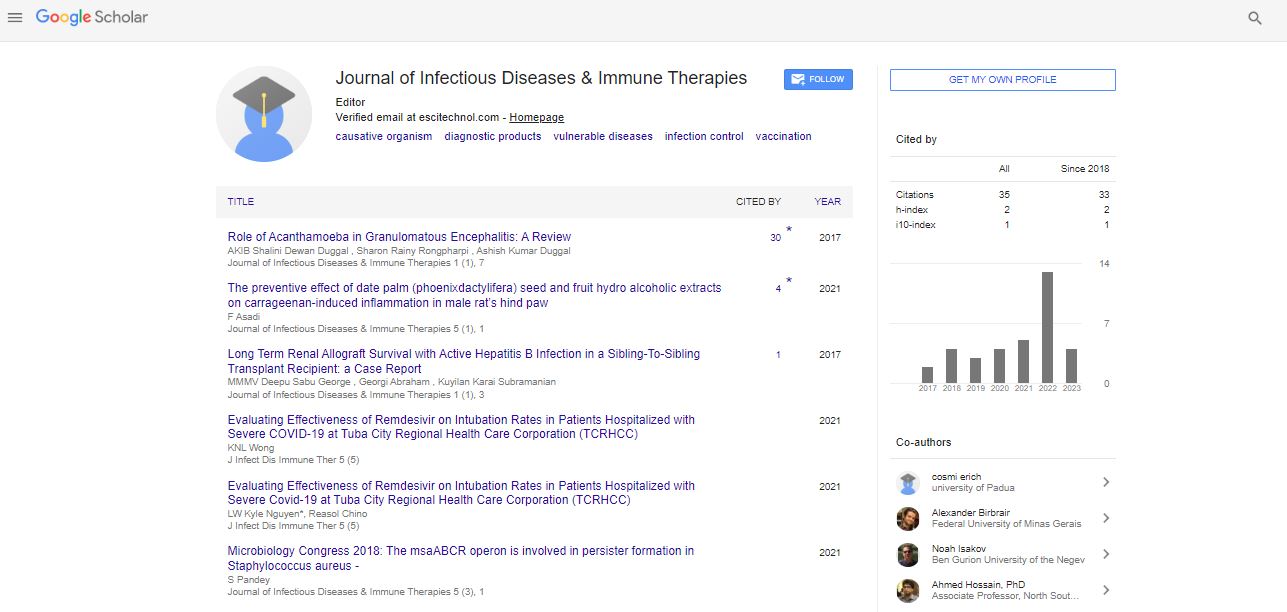Opinion Article, Vol: 12 Issue: 2
Leishmaniasis: An Overview of the Neglected Tropical Disease
Jonas Roberto*
Department of Cell and Developmental Biology, University College London, Gower Street, London WC1E 6BT, UK
*Corresponding Author: Jonas Roberto
Department of Cell and Developmental
Biology, University College London, Gower Street, London WC1E 6BT, UK
E-mail: jonas.hartmann@ucl.ac.uk
Received date: 27 May, 2023, Manuscript No. JIDITH-23-106357;
Editor assigned date: 29 May, 2023, Pre QC No. JIDITH-23-106357 (PQ);
Reviewed date: 15 June, 2023, QC No. JIDITH-23-106357;
Revised date: 23 June, 2023, Manuscript No. JIDITH-23-106357(R);
Published date: 30 June, 2023, DOI: 10.4172/2329-9541.1000345
Citation: Roberto J (2023) Leishmaniasis: An Overview of the Neglected Tropical Disease. J Immunol Tech Infect Dis 12:2.
Description
Leishmaniasis is a neglected tropical disease caused by protozoan parasites of the genus Leishmania. It affects millions of people worldwide, predominantly in impoverished regions. This manuscript provides a comprehensive overview of the disease, including its epidemiology, transmission, clinical manifestations, diagnosis, treatment, and prevention strategies. The aim is to increase awareness and understanding of leishmaniasis and contribute to the efforts aimed at its control and elimination.
Leishmaniasis is a complex vector-borne disease caused by the protozoan parasites of the genus Leishmania. It affects humans and animals and is transmitted through the bite of infected sandflies. Leishmaniasis is considered a neglected tropical disease due to its association with poverty, limited resources for prevention and control, and low visibility on the global health agenda. This manuscript provides an overview of the various aspects of leishmaniasis to aid in its recognition, diagnosis, treatment, and prevention.
Leishmaniasis is endemic in more than 98 countries, primarily in tropical and subtropical regions. The disease burden is highest in South America, East Africa, the Indian subcontinent, and the Middle East. It is estimated that around 1 billion people are at risk of infection, with an annual incidence of approximately 1 to 1.5 million cases. Leishmaniasis presents as different clinical forms, including cutaneous, mucocutaneous, and visceral leishmaniasis, each associated with specific Leishmania species and sandfly vectors.
Leishmaniasis transmission occurs when infected female sandflies. These insects act as vectors, transmitting the parasites to a susceptible host. The transmission cycle is influenced by various factors, including environmental conditions, vector behavior, reservoir hosts, and human activities. Zoonotic and anthroponotic transmission cycles exist, with animals such as dogs playing a crucial role in the maintenance of the disease.
The clinical manifestations of leishmaniasis range from localized cutaneous ulcers to systemic involvement. Cutaneous leishmaniasis is the most common form, characterized by skin lesions that may heal spontaneously but can also lead to disfiguring scars. Mucocutaneous leishmaniasis affects the mucous membranes of the nose, mouth, and throat, resulting in severe tissue destruction. Visceral leishmaniasis, also known as kala-azar, affects multiple organs and is potentially fatal if left untreated.
Diagnosing leishmaniasis involves a combination of clinical evaluation, laboratory tests, and parasite identification. Clinical signs and symptoms, along with a history of exposure in an endemic area, provide initial clues. Microscopic examination of stained tissue smears or aspirates can reveal the presence of amastigotes, the intracellular form of the parasite. Molecular techniques, such as Polymerase Chain Reaction (PCR), are increasingly used for accurate identification and species differentiation.
The treatment of leishmaniasis depends on the clinical form, severity, and geographical location. Available treatment options include antimonial drugs, amphotericin B, miltefosine, and paromomycin. The choice of drug and treatment duration varies among different regions and species. However, drug resistance, toxicity, and limited access to healthcare pose challenges to effective treatment. Research efforts are underway to develop new drugs and alternative therapies.
Preventing and controlling leishmaniasis involve a multifaceted approach. Vector control measures, such as insecticide-treated bed nets and indoor residual spraying, can reduce sandfly populations. Protective measures, including wearing long-sleeved clothing and using insect repellents, are also recommended. In endemic areas, reservoir control, such as treating infected dogs, can contribute to disease reduction. Vaccines are being developed, and their potential impact on disease control is promising.
Leishmaniasis remains a significant public health problem, particularly in impoverished regions with limited resources. Efforts to control the disease require a comprehensive approach that encompasses vector control, diagnosis, treatment, and prevention. Enhanced surveillance, increased access to accurate diagnostics and effective treatment, as well as innovative prevention strategies, including vaccines, are essential to reduce the burden of leishmaniasis and ultimately eliminate this neglected tropical disease.
 Spanish
Spanish  Chinese
Chinese  Russian
Russian  German
German  French
French  Japanese
Japanese  Portuguese
Portuguese  Hindi
Hindi 